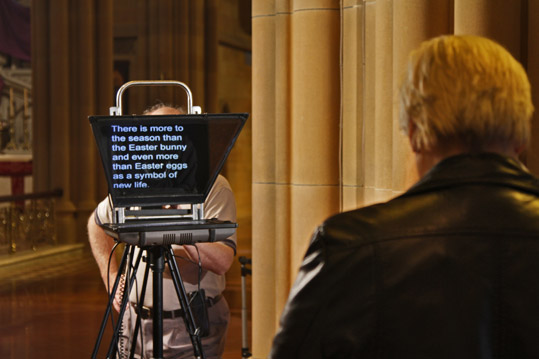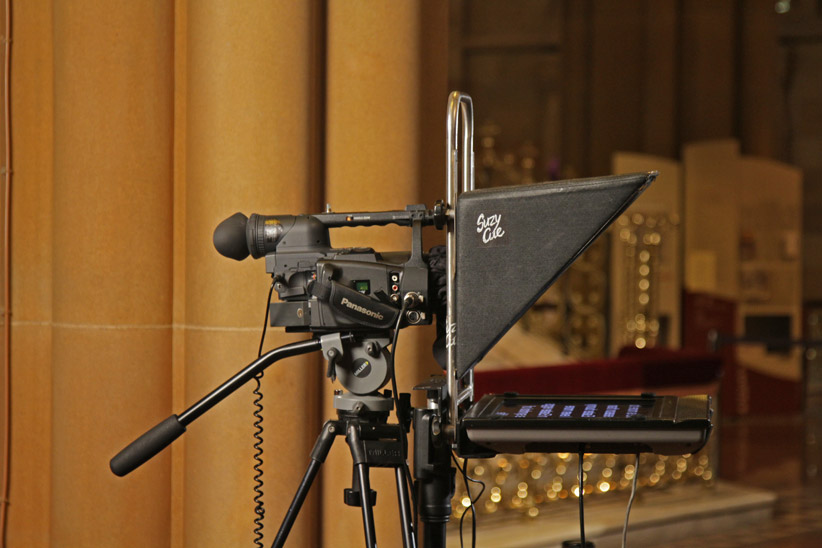There are many benefits to using autocue in corporate video production. This article will help you decide whether to use one.
Presenting to camera is not the same as public speaking.
Many people think that anyone who has experience in public speaking or addressing big groups won’t need the use of autocue for their piece to camera video. The reality is that for most people it can be a little daunting once you are in front of the camera, staring into a camera lens, trying to look composed and professional while desperately trying to remember the key points you want to get across. This applies to CEOs, subject matter experts and often even professional presenters. The camera picks up on all the stumbles, um’s, ah’s and most definitely all the breaks in dialogue if you don’t deliver the entire piece in one clean take. Everything changes once you’re in front of the camera. Using an autocue eliminates the added pressure of remembering what you need to say. Your words are right there in front of you. That’s a huge part of the job, done. All you need to do is ‘perform’ them and focus on holding the attention of your audience. There’s no memorisation or recall required.
This is what an autocue looks like.
It won’t look like you’re ‘reading’.
In a sense, when you’re in front of the camera, you are going to be ‘performing’. This includes wanting to come across as an expert in your topic, authentic, sincere and appearing unrehearsed. As such, you’d like to give the best performance you can. The key to using an autocue in a corporate video is to deliver your script as though you are not reading it, which is easy. Our experienced team can help the speaker to relax and give you simple techniques on how to present to your audience as opposed to looking like you’re reading a script. For one, subtle changes in delivery can really make a script flow as a conversational piece, not a document being read. Incidentally, our team are also able to edit scripts instantly. So, if at the shoot you decide to change some of the words, that’s no problem. This is an added benefit to using an autocue in a video production – the new words will be there, waiting for you.
Your talent can leave the shoot sooner.
Experience shows that video shoots are much quicker when using an autocue. An autocue helps with time efficiency for the speakers with their busy schedules. Not using an autocue can have the repercussion of filming the same piece to camera numerous times as the speaker may have left something out, stumbled over what they were saying or weren’t happy with their choice of words or just how it sounded. It happens all the time, even with CEOs. The worst part is, the more they try to get it right, largely, the harder it becomes for them and pressure to get it right builds. You can’t really ad-lib your way out of it as you might be able to do in a live, public speaking scenario, like a staff or client address, pitch or seminar. What usually follows is that their delivery worsens and the end video ends up being very choppy because the unflattering sections need to be taken out – not really what you originally envisioned. With an autocue you can be assured that all aspects of your speech or presentation will be covered in a much quicker, more time efficient manner. You’ll come across looking and sounding your best.
So, what’s next?
If you’ve decided to use an autocue for your next piece to camera video, congratulations. Here’s what you need to do next:
- Prepare an ‘autocue script’ – this is the entire script from top to bottom, word for word, in a Word document. Don’t use tables, tracked changes, cues for improvisation, lists or a PowerPoint document.
- Read the autocue script out loud (not just in your head) at a natural pace, to hear how it sounds. Is it too formal? Is it too long? Are there too many bullet point items? Have all the stakeholders approved it? Re-jig the script so that all these types of things are fixed.
- Email the script to us a day before the shoot so that the autocue operator can have it loaded and ready to go.
This article was written by Suzy Cue, autocue partners to Rocket Productions. For more information contact Rocket Productions.


